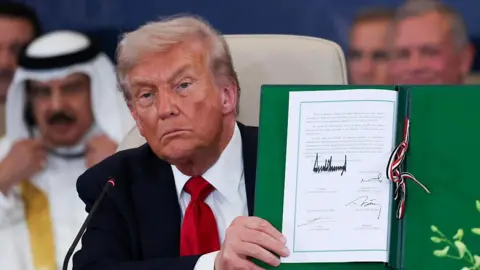Celebrations were held across Israel and the Palestinian territories, as Monday’s major hostage and prisoner exchange marked a significant step toward ending the two-year-old war in Gaza.
In a crucial first phase of the US-brokered plan to end the war, Hamas returned all living Israeli hostages, while Israel released nearly 2,000 Palestinian prisoners and detainees.
There were emotional scenes as the families of the Israeli hostages screamed and cried with happiness as they embraced their freed loved ones.
For Palestinians released from Israeli prisons, they were greeted by huge crowds waving flags and playing patriotic music as they arrived on buses in Gaza and the occupied West Bank.
US President Donald Trump arrived in Israel minutes after the first hostages were reunited with their families, and in a speech to the Israeli parliament, the Knesset, he announced a “historic dawn in a new Middle East.”
He then headed to a summit in Sharm el-Sheikh, Egypt, to meet with more than 20 leaders for talks on the next stages of his peace plan for Gaza.
At the summit, Egypt, Qatar, Turkey and the United States signed a declaration as guarantors of the ceasefire agreement that aims to end two years of war that left Gaza in ruins.
But amid the diplomatic celebrations and joy during reunions in Israel and the Palestinian territories, many challenges remain before us if we are to turn the ceasefire into a lasting peace.
The final stages of Trump 20-point peace plan It is fraught with sticking points, and intense negotiations will be needed to move forward.
Monday’s hostage and prisoner exchange completed the initial phase of the deal, and came after a ceasefire came into force on Friday and an increase in humanitarian aid entered Gaza over the weekend.
“I am overwhelmed with emotions and joy,” said Arbel Yehud, a former hostage who reunited with her accomplice Ariel Cuneo when he was released on Monday.
“For more than two years, the hope of holding Ariel again has been what motivates and drives me every day,” she said.
Although the hostage release went largely as planned, the families of the Israeli hostages expressed anger that Hamas said it would only return the bodies of four of the dead hostages.
The Israeli army said that it would conduct forensic examinations before confirming their identities and informing their families.
The remains of up to 24 other hostages are believed to remain in Gaza. The ceasefire agreement, reported by Israeli media, appeared to acknowledge that Hamas and other Palestinian factions may not be able to locate all the remains within the specified time frame.
Under the agreement, about 1,700 Palestinian detainees held by Israel without charge were released.
A Palestinian woman who met her son said that her heart was finally at peace.
A Palestinian man said, “Frankly, the happiness and joy are indescribable despite the suffering… We came today to celebrate.”
Israel also released about 250 Palestinian prisoners who were serving life sentences, including about 100 prisoners. Liberated in the occupied West Bank. Others were deported and a few were released in East Jerusalem.
As prisoners exited a Red Cross bus in Ramallah, many wearing traditional keffiyeh scarves, they were still greeted by loud cheers – but many looked pale and emaciated, and some were struggling to walk.
“There is joy, there is pain, there is happiness, and there is sadness,” said Khalil Muhammad Abd al-Rahman al-Qatrous, who gathered outside Nasser Hospital in Khan Yunis to bring his son, whom he said Israel had been holding for about three months.
After being received by Israeli Prime Minister Benjamin Netanyahu, Trump visited the Knesset, where he held the session The first speech by a US president since 2008.
“Finally, not only for the Israelis but for the Palestinians as well, the long and painful nightmare has finally ended,” he said in front of the hall during a long speech, and some politicians chanted “Trump, Trump, Trump.”
There was a brief interruption when an opposition member held up a piece of paper with the words “Recognize Palestine” written on it.
Trump then flew to Sharm El Sheikh where he met with more than 20 world leaders — including British Prime Minister Sir Keir Starmer, French President Emmanuel Macron, and leaders of several Muslim and Arab countries.
He posed for photos with other leaders on a podium bearing the words “Peace in the Middle East.”
Also in attendance was former UK Prime Minister Tony Blair, who – under Trump’s plan – is set to play a key role in the Gaza “peace council” that will be chaired by the US president.
 Getty Images
Getty ImagesThe plan will see Gaza initially run by a temporary transitional committee of Palestinian technocrats overseen by a “peace council,” before eventually transferring power to the Palestinian Authority once it undergoes reforms.
But difficult negotiations will be needed to move forward with the final stages of the plan.
Among the points of contention are the extent and timetable for the withdrawal of Israeli forces, the disarmament of Hamas, and the future governance of the Gaza Strip.
Hamas had previously said it would not disarm unless a Palestinian state was created – and rejected the idea of foreign rule in Gaza.
Netanyahu rejected any future participation of the Palestinian Authority.
When asked when the second phase of negotiations on the peace agreement would begin, Trump replied: “It has begun.”
“The stages are all a little mixed together,” he added.
Israel launched its attack in response to the Hamas-led attack on southern Israel on October 7, 2003, which left 1,200 people dead and 251 others taken hostage in Gaza.
Since then, more than 67,000 people have been killed in the Israeli offensive, according to the Hamas-run Health Ministry in Gaza. Its numbers are considered reliable by the United Nations and other international bodies. More than 9 out of 10 residential buildings were damaged or destroyed, according to the United Nations.
https://ichef.bbci.co.uk/news/1024/branded_news/18f7/live/f0d48700-a877-11f0-928c-71dbb8619e94.jpg
Source link
